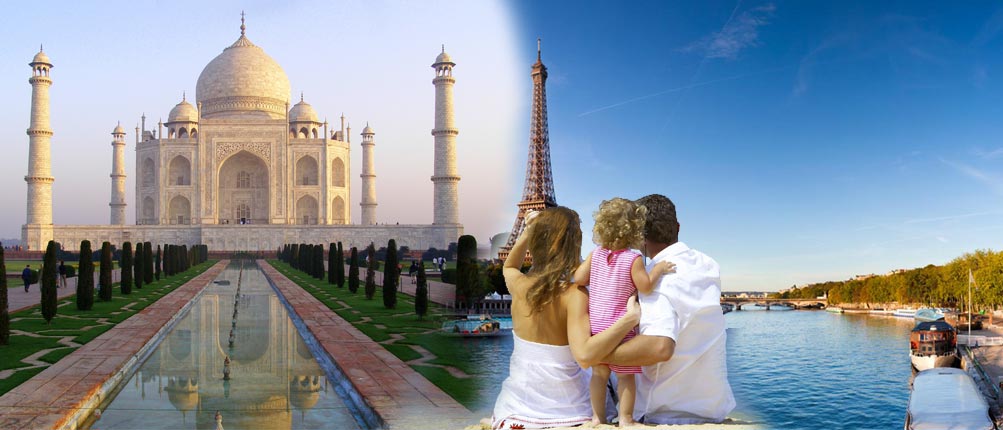




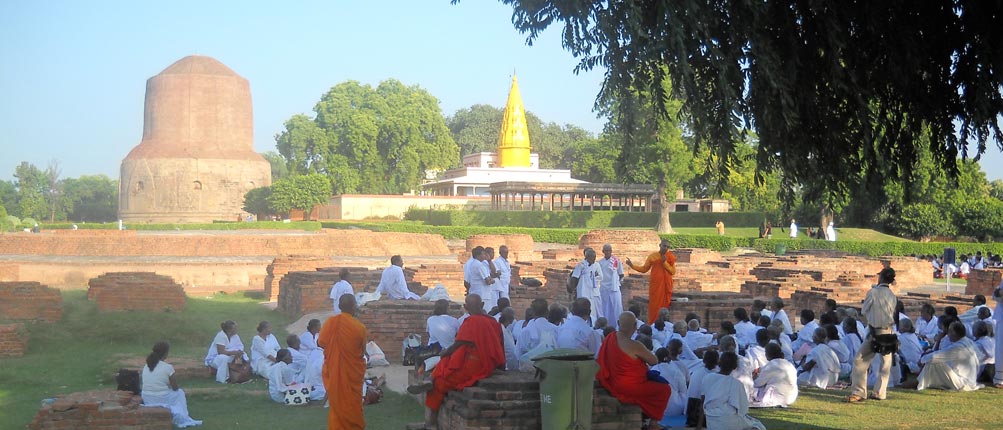



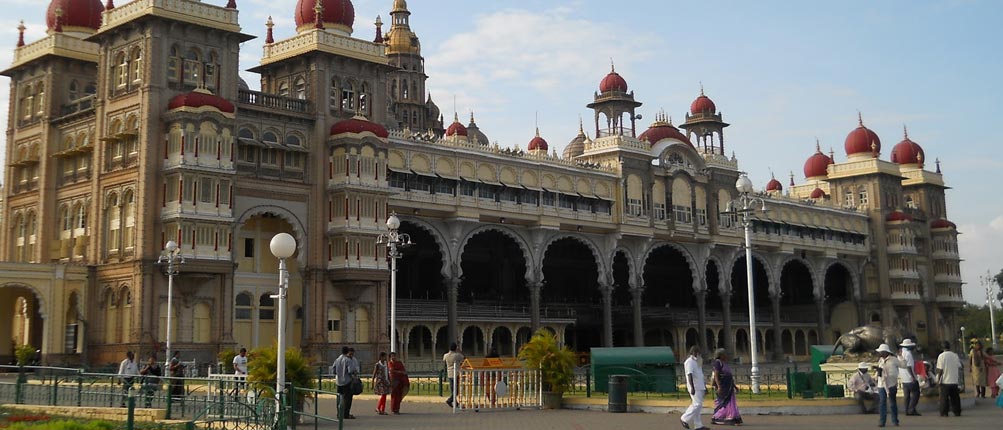
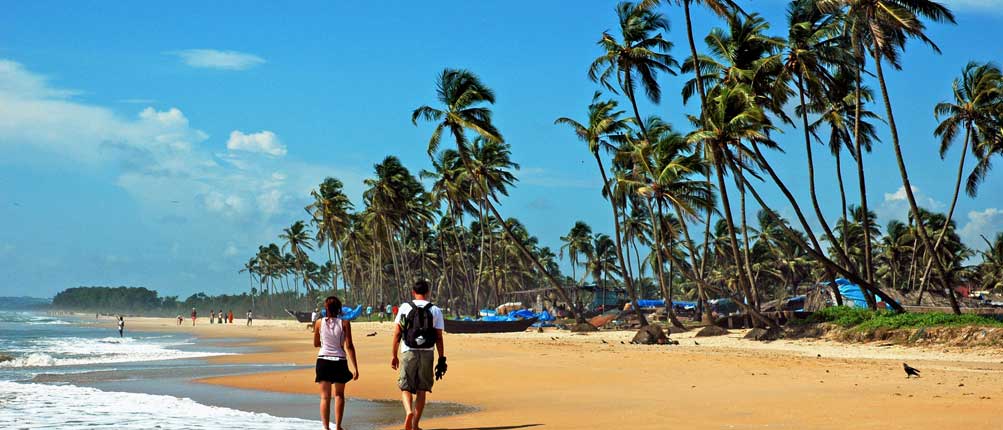


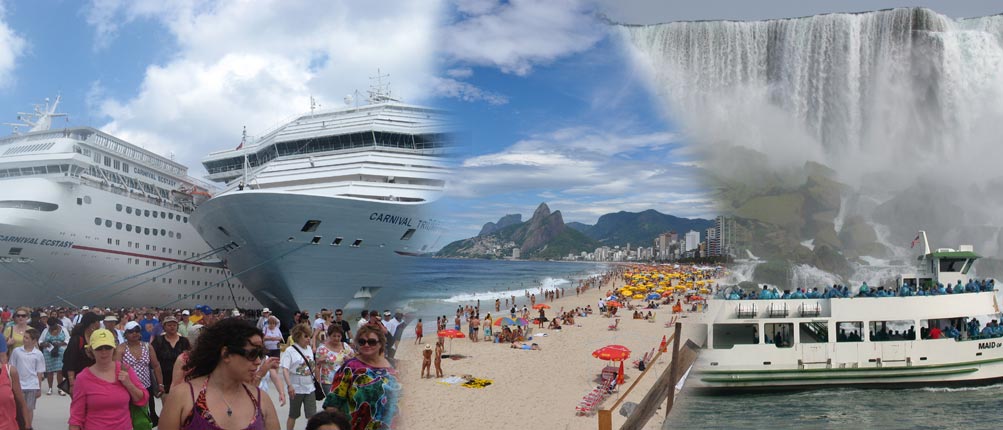
Wildlife Tour Of India
Mumbai * Nagpur * Kanha * Bandhavgarh * Khajuraho Agra * Ranthambore * Jaipur * Delhi - 15 Nights/16 Days
India… a country which will enchant you with her beauty and diversity, delight you with her colorful pageantry, enrich you with her culture, stun you with her modernity, embrace you with her warmth, and overwhelm you with her hospitality…a land where the ancient and the contemporary exist side by side, where thousands of brilliant images fill the soul with wonder and where quaint and startling contradictions juxtapose to lend an extraordinary vitality, texture and poetry to life.
Explore the wild jungles and forests of India on India Wildlife Tours. Feel the excitement of seeing a majestic tiger prowling in a jungle, or elephants and rhinos trampling their way through the tall grass of a National Park in India. See amazing animals on wildlife safari tours in India. Spot wild creatures and explore nature tracts inhabited by rare birds on India Wildlife Tours. Come face to face with a sloth bear or a wild hyena; feel the thrill of photographing a wild lion on the prowl and experience an Indian jungle safari on an India Wildlife Tour. India Wildlife Tours offers unforgettable adventure tours and nature tours to India. Tour India, a land of natural beauty and wonder with exciting India Tours.
Day 01 Arrive: Mumbai By: International Flight
You will arrive at Mumbai’s International Airport. Following customs, immigration formalities and baggage collection, our representative
will meet you as you EXIT the ARRIVALS TERMINAL building after which you would be transferred to your hotel. 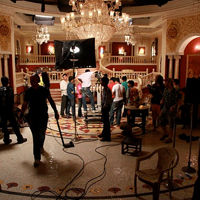
Mumbai - It is young, its lively and a confluence of varied cultural currents and cross currents have given Mumbai a unique position of the most multi-ethnic city of India. The capital city of Maharashtra State, formerly known as Bombay lies in the southwestern part of India. Oozing with the cocksure self-confidence of a maverick moneymaker and "Bindass" (carefree) attitude, Mumbai is also country's financial and commercial hub and has a principal port on the Arabian Sea. Mumbai is the hub of Indian film industry, which has played a pivoted role in the development of cinematography. "Bollywood", as it is called, produces the second most number of pictures in the world every year, next only to Hollywood, Mumbai claims to be the world's largest production centre for films.
Upon arrival proceed for check-in at hotel.
Overnight in Mumbai
Day 02 Mumbai
Buffet breakfast at hotel, you will proceed for sightseeing tour of Mumbai City.
The tour starts from the Gateway of India, which is a major landmark of Bombay, and was before the advent of air travel, the only gateway to India. You will be then driven along Marine Drive, the sea - Front Boulevard. It is also known as the Queen’s Necklace as in the evening, the breeze from the Arabian Sea comes over Marine Drive and as the streetlights on this U-shaped road light up, the view from south Bombay’s skyscrapers or from the exclusive residential area, is that of a Queen’s Necklace. You will be also driven along Malabar Hill and Hanging Gardens, which is built over Bombay’s reservoir. Continue to Mani Bhawan (Gandhi Memorial), the house where the Father of the Nation stayed during his early visits to the city. The room, in which Gandhi stayed, preserved as it was, and the scenes of Gandhi’s life in photographs and models are of special interest.
The last stop before proceeding to the hotel is the Prince of Wales Museum– gothic and Moorish architecture in the striking confluence of styles that came to be known as Indo Saracenic. Most impressive are the miniature paintings – nearly 2000 of them – from various stylistic schools of India
After sightseeing return to your hotel
Overnight in Mumbai
Day 03 Mumbai – Nagpur By: Flight - Nagpur – Kanha By: Surface
Early morning you will be transferred to the airport in time for your flight to Nagpur:
Upon arrival you will be driven to Kanha national Park (197 Km / 4 hours), upon arrival check-in at your hotel.
Later buffet lunch at the hotel
In the afternoon, an exclusive lecture on ‘Wild life in Kanha” will be arranged for you. The naturalist will also share in information about Indian Wildlife and its habitat. Project Tiger will also be one of the topics covered by him.
Dinner & Overnight at the hotel in Kanha
Day 04 & 05 Kanha
Two days of game viewing around the park.
Spread over a massive area of 1945 sq. km, Kanha is in the heart of Kipling Country, the setting of the Jungle Book. 
KANHA NATIONAL PARK and Tiger Reserve is considered one of Asia's finest protected areas and probably the best place in the world to see tigers in the wild. It offers a great diversity of wildlife. Chances of seeing the Indian Bison here are much better than Bandhavgarh. You also might spot a pack of Dholes - the Indian Wild Dog, also known as the whistling hunters, Dholes are known for their perseverance in hunting down their quarry. Kanha is also the last refuge of the Swamp Deer (Hard Ground), only 400 or so survive in the wildlife and all of them are to be found in Kanha.
Buffet lunch, dinner & overnight at the hotel in Kanha
Day 06 Kanha – Bandhavgarh
After breakfast you will be driven to Bandhavgarh (265 Km / 6 hours). Upon arrival, proceed for check-in at your hotel.
Late buffet lunch at the hotel
Afternoon hop on to your jeeps for Game viewing
Dinner & Overnight at the hotel in Bandhavgarh
Day 07 Bandhavgarh
Two game viewing drives around the park
The reserve is named after the highest hill in the state of Madhya Pradesh. Bandhavgarh has been an excellent habitat of tiger and is known for the highest density of tigers in the world. During these drives you stand a very good chance of seeing the Lord of the Indian Jungle the tiger.
A relatively small park, Bandhavgarh is one of the smallest tiger reserves holding such a large population of tigers (49 according to the 1997 census). Set in rugged terrain with many hills, the forested area is interspersed with savanna like areas known as Chaurs. These wildernesses support a rich variety of wildlife that includes Tiger, Leopard, Gaur (Indian Bison), Sloth Bear, Sambar, Spotted Deer, Barking Deer, Chowsingha (Four horned Antelope), and Wild Pigs etc. It has also rich birdlife.
Buffet lunch, dinner & overnight at the hotel in Bandhavgarh
Day 08 Bandhavgarh - Khajuraho
Morning hop on to your jeeps for another game drive.
After breakfast, drive to Khajuraho, home of the famed erotic stone carved temples. (275 Km / 6 hours). 
In 1838 Captain T.S. Burt, who was working with the Asiatic Society in Calcutta, followed up local rumours and discovered the great temple complex rising above the jungle in Khajuraho. The ruins of the original Chandela capital stretch over 21 square kilometres, but very little apart from the temples remain. The temples here were built between 950 and 1050 A.D. by the Chandela dynasty, which claims descent from the Moon God and a mortal, Hemavati, with whom the god fell in love.
Most of the temples of the north were destroyed by invaders, but Khajuraho escaped and stands today as an island of beauty. Khajuraho is not something that can be described in words - it has to be experienced.
PM: Tour of the Chandela Temple Complex.
The tour concentrates on the famous erotic temples, which represent some of the finest examples of temple architecture in Northern India. The remote location of Khajuraho meant that the temples were unharmed by Muslim invaders and as a result, the intricately fine carvings are in very good condition and are said to represent life in heaven.
Overnight in Khajuraho
Day 09 Khajuraho – Jhansi - Jhansi – Agra By: Train 
After a leisurely buffet breakfast, drive to the Jhansi Railway station (5 Hours) your train to Agra (Shatabdi Express, 1811/2038 hrs).
Upon arrival in Agra you will be transfer to your hotel.
Agra in terms of ambiance is still associated with its Mughal period. The Mughals besides being great rulers were also great builders and they preserved their best architectural wonders for Agra & its neighbourhood. It has many wonderful monuments and the Taj Mahal, the greatest of them all, is a masterpiece of Mughal architecture at its best. The massive but elegant Agra Fort, the delicate artistry of Itimad-ud-daulah’s tomb, the magnificent Taj and Akbar’s deserted capital, Fatehpur Sikri, are each unique and outstanding. Their architectural genius can also be seen in the forts, palaces and aesthetically laid out gardens - each one a silent witness to a grand style of a golden era.
Overnight in Agra
Day 10 Agra
Early morning, you will be proceed for a sunrise tour of the Taj Mahal (closed on Fridays). Midway Tonga’s “horse carriages” would be waiting
for you and will drop you at the gates of the Taj Mahal. 
The Taj Mahal is everything that has been said about it and more. Taking 22 years and 20,000 men to build, the white marble was quarried 200 miles away and was transported to the site by a fleet of 1000 elephants. Built by the Mughal Emperor Shah Jahan as an expression of his love for his wife Mumtaz Mahal, in mid 17th century, the Taj Mahal is truly one of the wonders of the world. Though the Taj appears to be amazingly perfect from almost any angle, it is the close-up marble inlay work, which is really astounding. You will have ample time to view and be mesmerized by this outstanding piece of architecture.
Return to your hotel after the sunrise tour for buffet breakfast.
After breakfast proceed to visit the Agra Fort, an outstanding example of Mughal architecture. Agra Fort - the seat and the stronghold of the Mughal Empire under successive generations. This was the seat of Mughal rule and administration and the present structure owes its origins to Akbar who erected the walls and gates and the first buildings on the eastern banks of Yamuna River. Shah Jehan added the impressive quarters and the mosque while Aurangzeb added the outer ramparts. Visit its Hall of Public Audience and its Royal Pavilions.
Overnight in Agra
Day 11 Agra -Bharatpur–Ranthambore By:Surface/Train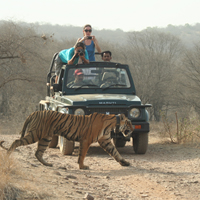
After the breakfast in time you will be drive to Bharatpur Railway Station to board the train for Ranthambore (Golden Temple Mail, 1045/1305 hrs).
Afternoon you will arrive at Sawai Madhopur Railway station, upon arrival transfer to your hotel
Ranthambore National Park is one of the prime examples of Project Tiger’s conservation efforts in Rajasthan. The forests around the Ranthambore Fort were once, the private hunting grounds of the Maharajas of Jaipur. The Park sprawls over an estimated area of 400 sq Kms. Steep crags embrace a network of lakes and rivers, and atop one of these hills, is the impressive Ranthambore Fort, built in the 10th century. The entire forest is peppered with the battlements and spillovers of the Ranthambore Fort - tigers are said to frequent these ruins, too. As a result of stringent efforts in conservation, tigers, the prime assets of the Park, have become more and more active during the day. More than in any other park or sanctuary in India, tigers are easily spotted here in daylight. They can be seen lolling around lazily in the sun, or feverishly hunting down Sambar around the lakes.
Lunch at the hotel
PM: Game-viewing drive.
Overnight at Ranthambore
Day 12 Ranthambore
Two game viewing drives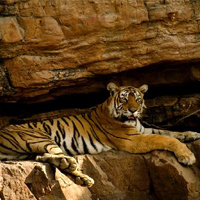
Apart from wildlife viewing you will also be taken to the Ranthambore Fort built in the 10th century, which commands a panoramic view of the Tiger Reserve. The fort also houses some splendid monuments within its precincts.
Overnight at Ranthambore
Day 13 Ranthambore - Jaipur
AM: Early morning game viewing drive.
Return to your hotel for breakfast. After breakfast you will be driven to Jaipur (195 Km / 04 hours), upon arrival check-in at hotel.
Rajasthan’s kingdoms are an enduring legacy to India’s history. A land endowed with invincible forts, magnificent palaces ad waves of sand dunes and serene lakes. No other region in the country assembles the many paradoxes of India, as does the desert land of Rajasthan. By far it is the most colourful region in India.
Jaipur's past is never too far from hand. The city of victory, Jaipur presides over the fascinating desert state and its people: surrounded by rugged hills, each crowned by a formidable fort; and beautiful palaces, mansions and gardens dotted throughout its precincts. The palaces and forts of yesteryear that were witness to royal processions and splendour are now living monuments, accepted quite naturally into the lifestyles of the people of the "pink city". With its historical past, Jaipur revives legends of the ancient Rajputs. The dresses of the women and the turbans of the men add colour to this fascinating city.
Afternoon is at leisure for independent activities.
Overnight in Jaipur
Day 14 Jaipur
An excellent breakfast energizes you for the visit Amber Fort (pronounced "am-er," with a silent "b") by jeeps / Elephant. Riding an elephant takes you back to the royal era, when only the kings use to ride on these majestic beasts.
Amber - the former capital of Jaipur state stunningly situated on a hillside and overlooking a lake which reflects its terraces and ramparts. Amber is a fortified complex of many splendid palaces evolved over a period of six centuries. On the way, we'll pause to visit an elephant stable to visit with the animals and their mahouts (riders).
Proceed for city tour of Jaipur.
We’ll stop and see the `Palace of Winds’, otherwise known as Hawa Mahal. It is really an elaborate facade behind which the ladies of the court used to watch the daily goings on in the street below. It is extremely intricate in its pink sandstone carving. The cool wind blows through its facade of windows and latticed screens through which the queens of the court once viewed the streets of the city. You will also have the opportunity to wander about the local markets.
Among the highlights to be seen while touring Jaipur include the City Palace, which is an overwhelming complex of exquisite palaces, gardens and courtyards, decorative art and carved doorways. The palace museum houses collections of rare manuscripts, armoury, costumes, carpets and miniature paintings. Walk to the adjacent Jantar Mantar or Astronomical Observatory made by the Maharaja of Jaipur, built in 1726 and is one of the five such astronomical wonders built by Sawai Jai Singh and makes accurate predictions even to this day.
While returning we'll also have an opportunity to visit a jeweler's to learn about the gems that India is so justly famous.
Return to your hotel after the sightseeing tour.
Overnight in Jaipur
Day 15 Jaipur - Delhi
After buffet breakfast you will be driven to Delhi (268 Km / 5 hours), upon arrival check-in at hotel.
India’s capital and a major gateway to the country, contemporary Delhi is a bustling metropolis, which successfully combines in its folds - the ancient with the modern. Amidst the fast spiraling skyscrapers the remnants of a bygone time in the form of its many monuments stand as silent reminders to the region’s ancient legacy. The first impressions for any visitor traveling in from the airport are of a specious, garden city, tree-lined with a number of beautiful parks.
Overnight in Delhi.
Day 16 Departure Delhi
After buffet breakfast at the hotel, you will proceed for a full day city tour of Old & New Delhi.
You will first visit Old Delhi. The tour will begin with a visit to Raj Ghat, a simple memorial to Mahatma Gandhi; drive past the Red Fort continuing to the Jama Masjid walk down the colourful streets of Chandni Chowk to reach Jama Masjid, one of Asia’s largest mosques and which is viewed from the outside. People stream in and out of the mosque continuously and the presence of a nearby bazaar means that the area is rarely quiet.
After visiting Old Delhi, you will be driven to New Delhi, which reflects the legacy the British left behind. The division between New and Old Delhi is the division between the capitals of the British and the Mughals respectively. The division in the walled city and New Delhi also marks the division in the life-styles. The walled city is all tradition where one will be able to glean a past life-style in all its facets, colours and spells. New Delhi in contrast, is a city trying to live up to the best of 21st century standards.
The tour to Imperial Delhi will include a visit to the Qutub Minar, the tallest stone tower in India. Qutub-ud-din Aibak started it in 1199. Pulling down 27 Hindu and Jain temples and using their columns erected the attached Quwwat-ul-Islam mosque also built by him. Then visit Humayun’s tomb, built by the widow of the second Mughal Emperor, Humayun, it is an outstanding monument in the Indo-Persian style, a precursor of the Taj Mahal. The tour also includes a drive past the imposing India Gate, the Parliament building and the Rastrapathi Bhawan, the President’s residence.
Return to your hotel after the sightseeing tour.
Later in the evening our representative will transfer you to International Airport, in time to board your flight back home. (Room shall block for you till the departure).








